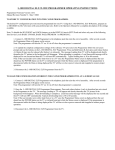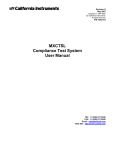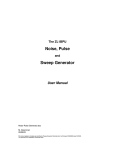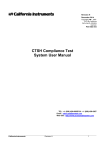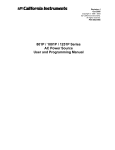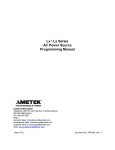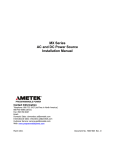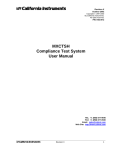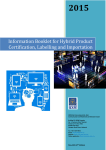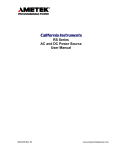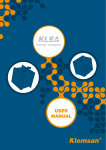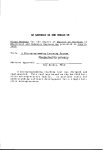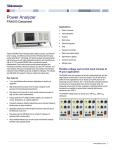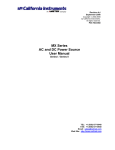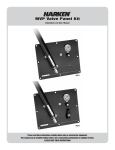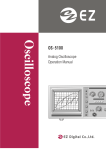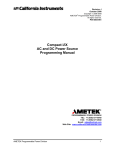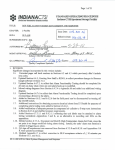Download Rev C
Transcript
MX Compliance Test System System Administrator Manual MX Compliance Test System System Administrator Manual MXCTSH / MXCTSL Revision B 1 MX Compliance Test System System Administrator Manual SAFETY SUMMARY These power system components contain high voltage and current circuits that are potentially lethal. The following safety guidelines must be followed when operating or servicing this equipment. These guidelines are not a substitute for vigilance and common sense. California Instruments assumes no liability for the customer's failure to comply with these requirements. APPLYING POWER AND GROUNDING Verify the correct voltage is applied to the equipment. Verify that the input power to the PACS-3-75 unit is plugged into a properly grounded utility outlet. FUSES Use only fuses of the specified current, voltage, and protection speed. Do not short out the fuse holder or use a repaired fuse. The PACS-3-75 unit uses a North-American ferrule type input fuse rated at 0.5A and 250Volts. (Fast Acting) DO NOT OPERATE IN A VOLATILE ATMOSPHERE Do not operate the system in the presence of flammable gases or fumes. DO NOT TOUCH ENERGIZED CIRCUITS Disconnect power cables before servicing this equipment. Even with the power cable disconnected, high voltage can still exist on some circuits. Discharge these voltages before servicing. Only qualified service personnel may remove covers, replace components or make adjustments. DO NOT SERVICE ALONE Do not remove covers, replace components, or make adjustments unless another person, who can administer first aid, is present. DO NOT EXCEED INPUT RATINGS Do not exceed the rated input voltage or frequency. Additional hazards may be introduced because of component failure or improper operation. DO NOT MODIFY INSTRUMENT OR SUBSTITUTE PARTS Do not modify these instruments or substitute parts. Additional hazards may be introduced because of component failure or improper operation. MOVING THE POWER SOURCE When moving the power source, observe the following: 1. Remove all AC power to system components. 2. Use two people to prevent injury. Revision B 2 MX Compliance Test System System Administrator Manual CTSMXH / CTSMXL Software License Your Compliance Test System (MXCTS) was shipped with one copy of the CTSMXH software, CTSMXL software or both. This software - model number CIC 651 and CIC652 respectively - is owned by California Instruments and is protected by United States copyright laws and international treaty provisions. Therefore, you must treat the software like any other copyrighted material. Software Revisions Revision codes in the Help About screen of the CTSMXH / CTSMXL software indicate the current revision. Minor changes to the software such as bug fixes usually do not require a change to the manual. Therefore, the revision number of the software you received with the MXCTS system may be higher than the software revision number shown below. In this case, the information in the manual still applies. Software changes that require a manual change will be accompanied either by a new edition of the manual or an errata sheet documenting the changes. This manual applies to software revision 1.4.0.2 or higher. Printing History The manual printing date indicates the current edition. The printing date changes with each new edition or update. Update packets or change sheets may be issued between editions to correct or add information. Minor corrections incorporated at reprint do not cause a new edition. August 2006 First Edition, Revision B Trademarks Windows 98™, Windows 2000™, Windows XP™, MS Word™, and MS Excel™ are registered trademarks of Microsoft Corporation. Contacting California Instruments To contact California Instruments, use any of the communication channels listed here: Mail: California Instruments 9689 Towne Centre Drive San Diego, CA 92121-1964 USA Phone: 858 677 9040 7:00 AM - 4:00 PM Pacific Standard Time Voice Mail 24 hours Fax: 858 677-0940 Email: [email protected] Web site: www.calinst.com Revision B 3 MX Compliance Test System System Administrator Manual ONE YEAR WARRANTY CALIFORNIA INSTRUMENTS CORPORATION warrants each instrument manufactured by them to be free from defects in material and workmanship for a period of one year from the date of shipment to the original purchaser. Excepted from this warranty are fuses and batteries that carry the warranty of their original manufacturer where applicable. CALIFORNIA INSTRUMENTS will service, replace, or adjust any defective part or parts, free of charge, when the instrument is returned freight prepaid, and when examination reveals that the fault has not occurred because of misuse, abnormal conditions of operation, user modification, or attempted user repair. Equipment repaired beyond the effective date of warranty or when abnormal usage has occurred will be charged at applicable rates. CALIFORNIA INSTRUMENTS will submit an estimate for such charges before commencing repair, if so requested. PROCEDURE FOR SERVICE If a fault develops, notify CALIFORNIA INSTRUMENTS or its local representative, giving full details of the difficulty, including the model number and serial number. On receipt of this information, service information or a Return Material Authorization (RMA) number will be given. Add RMA number to shipping label. Pack instrument carefully to prevent transportation damage, affix label to shipping container, and ship freight prepaid to the factory. CALIFORNIA INSTRUMENTS shall not be responsible for repair of damage due to improper handling or packing. Instruments returned without RMA No. or freight collect will be refused. Instruments repaired under Warranty will be returned by prepaid surface freight. Instruments repaired outside the Warranty period will be returned freight collect, F.O.B. CALIFORNIA INSTRUMENTS 9689 Towne Centre Drive, San Diego, CA 92121-1964. If requested, an estimate of repair charges will be made before work begins on repairs not covered by the Warranty. DAMAGE IN TRANSIT The instrument should be tested when it is received. If it fails to operate properly, or is damaged in any way, a claim should be filed immediately with the carrier. A full report of the damage should be obtained by the claim agent, and a copy of this report should be forwarded to us. CALIFORNIA INSTRUMENTS will prepare an estimate of repair cost and repair the instrument when authorized by the claim agent. Please include model number and serial number when referring to the instrument. Revision B 4 MX Compliance Test System System Administrator Manual LIMITATION OF WARRANTY California Instruments believes the information contained in this manual is accurate. This document has been carefully reviewed for technical accuracy. In the event that technical or typographical errors exist, California Instruments reserves the right to make changes to subsequent editions of this document without prior notice to holders of this edition. The reader should consult California Instruments if errors are suspected. In no event shall California Instruments be liable for any damages arising out of or related to this document or the information contained in it. CALIFORNIA INSTRUMENTS PROVIDES NO WARRANTIES, EXPRESS OR IMPLIED, AND SPECIFICALLY DISCLAIMS ANY WARRANTY OF MERCHANTABILITY OR FITNESS FOR A PARTICULAR PURPOSE OF THIS SOFTWARE AND DOCUMENTATION. CALIFORNIA INSTRUMENTS WILL NOT BE LIABLE FOR DAMAGES RESULTING FROM LOSS OF DATA, PROFITS, USE OF PRODUCTS, OR INCIDENTAL OR CONSEQUENTIAL DAMAGES, EVEN IF ADVISED OF THE POSSIBILITY THEREOF. This limitation of liability of California Instruments will apply regardless of the form of action, whether in contract or tort, including negligence. The warranty provided herein does not cover damages, defects, malfunctions, or service failures caused by owner’s failure to follow California Instruments’ installation, operation, or maintenance instructions; owner’s modification of the product; owner’s abuse, misuse, or negligent acts; and power failures, surges, fire, flood, accident, actions of third parties, or other events outside reasonable control. SOME STATES DO NOT ALLOW LIMITATIONS ON THE LENGTH OF AN IMPLIED WARRANTY OR THE EXCLUSION OR LIMITATION OF INCIDENTAL OR CONSEQUENTIAL DAMAGES, SO THE ABOVE LIMITATION OR EXCLUSIONS MAY NOT APPLY TO YOU. THIS WARRANTY GIVES YOU SPECIFIC LEGAL RIGHTS, AND YOU MAY ALSO HAVE OTHER RIGHTS WHICH VARY FROM STATE TO STATE. If any part of this Agreement shall be determined by a court to be invalid, illegal or unenforceable, the remaining provisions shall in no way be affected or impaired thereby. GOVERNING LAW. This Agreement and Limited Warranty are governed by the laws of the state of California without regard to conflict of law provisions. INSTALLATION AND / OR USE OF THIS PROGRAM CONSTITUTES ACCEPTANCE OF THESE TERMS AND RESTRICTIONS BY THE USER. © 1997 - 2006 COPYRIGHT Under the copyright laws, this publication may not be reproduced or transmitted in any form, electronic or mechanical, including photocopying, recording, storing in an information retrieval system, or translating, in whole or in part, without the prior written consent of California Instruments Corporation. California Instruments Corporation, © 1997 - 2006 Warning regarding Medical and Clinical use of California Instruments products. California Instruments products are not designed with components and testing intended to ensure a level of reliability suitable for use in the treatment and diagnosis of human beings. California Instruments products are NOT intended to be used to monitor or safeguard human health and safety in medical or clinical treatment and California Instruments assumes no responsibility for this type of use of its products or software. Revision B 5 MX Compliance Test System System Administrator Manual Table of Contents 1 Introduction .......................................................................................................................................... 7 2 Configuration Program........................................................................................................................ 8 2.1 2.2 2.3 2.4 2.5 2.6 3 Configuration Limits.......................................................................................................................... 13 3.1 3.2 3.3 3.4 3.5 4 Accessing the General Configuration Screen ................................................................................ 8 Password ........................................................................................................................................ 9 Changing General Configuration Settings...................................................................................... 9 Changing Hidden Configuration Settings ....................................................................................... 9 Configuration Option Selection - CTSMXL................................................................................... 10 Configuration Option Selection - CTSMXH .................................................................................. 11 Configuration Limits - Miscellaneous............................................................................................ 13 Configuration Limits - Voltage Distortion ...................................................................................... 19 Configuration Limits - Transitory State Harmonics - CTSMXL ..................................................... 20 Configuration Limits - Transitory State Harmonics - CTSMXH .................................................... 21 Configuration Limits - Flicker ........................................................................................................ 22 Measurement Uncertainty................................................................................................................. 23 4.1 4.2 4.3 4.4 4.5 Introduction ................................................................................................................................... 23 ISO/IEC 17025:1999 Standard..................................................................................................... 23 Statements of Compliance - Effect of Uncertainty........................................................................ 24 Uncertainty of the MXCTS System............................................................................................... 24 Adding Uncertainty Information to MXCTS Test Reports............................................................. 26 Table of Tables Table 4-1: CTS Measurement Uncertainty - Harmonics............................................................................. 25 Table 4-2: CTS Measurement Uncertainty - Flicker ................................................................................... 26 Revision B 6 MX Compliance Test System System Administrator Manual 1 Introduction This manual is intended for the system administrator of the MX45-3Pi-CTSH and MX45-3Pi-CTSL compliance test systems. Several aspects of the CTSMXH/L software operation can be set using the configuration module. This includes IEC test limits, modes of operation, feature selection etc. These settings are password protected to ensure that no changes by unauthorized personnel are made. As a system administrator however, you have the option of changing any aspect of the MXCTS configuration. Note that doing so may invalidate the compliance to existing IEC test standards. The MXCTS system is shipped with all parameters set to comply with prevailing IEC standards at the time of shipment. Making changes to any of these password-protected features is done solely at your own risk. The following aspects of the CTSMXH/L software operation can be changed using the Ctsmxl_config.exe or the Ctsmxh_config.exe program: • EN/IEC Harmonics Limits for class A, B, C and D. - (CTSMXL only) • EN/IEC Harmonics Limits for Stage 1 and Stage 2 connections. (CTSMXH only) • EN/IEC Flicker transfer function for 50 Hz and 60 Hz flicker operation • EN/IEC Flicker test limits for Pst, dc, dt and dmax • Source voltage distortion limits for IEC harmonics test • Miscellaneous parameters All parameters and settings are stored in the test_summary.mdb database located in the database subdirectory. The CTSMXL and CTSMXH programs each maintain there own database in their own sub directories. These databases are NOT interchangeable. Changes are time stamped and the user name is logged with the changes for audit purposes. Do not attempt to edit this database in any other way than using the supplied Ctsmxl_config.exe or Ctsmxh_config.exe programs. If this database gets corrupted, the main CTSMXH/L program will not function. Revision B 7 MX Compliance Test System System Administrator Manual 2 Configuration Program The chapter covers the various setup tabs available in the configuration program (Ctsmxh_config.exe or Ctsmxl_config.exe). It also provides the required instructions to bring up the protected area of the Config.exe program. The operator may use the Ctsmxl_config.exe or the Ctsmxh_config.exe program at any time to display general setup and configuration information. Without a password however, none of this information can be changed. In addition to this general setup screen, there are hidden screens that may be used to change key system parameters and test limits. These screens are also password protected. 2.1 Accessing the General Configuration Screen Any operator of the MXCTS system can access the general configuration screen by selecting the program shortcut for the Configuration program from the Windows Start menu. This shortcut is located in the CTSMXH or CTSMXL program group. Once a user name is provided (optional for read-only access), the user can click on the "View/Update calibration information" button. The screen shown below will appear. Note that no password entry is required to gain read-only access. The operator can review configuration data shown but can make no changes to it. This information is also covered by the MXCTSH User Manual (P/N 7003- 972) or MXCTSL User Manual (P/N 7003- 973). Refer to this manual for further information on this screen. Revision B 8 MX Compliance Test System 2.2 System Administrator Manual Password The configuration password is shown here. Note that this password is not case sensitive. Cal_lock 2.3 Changing General Configuration Settings Open the Configuration program as described before. After entering your name, enter the password in the password entry box. Then click on the "View/Update calibration information" button. The same configuration data will be shown only this time, changes can be made. When the configuration screen is closed, all changes made are stored in the test_summary.mdb database along with the login name and date. This information is also covered by the MXCTSH User Manual (P/N 7003- 972) or MXCTSL User Manual (P/N 7003- 973). Refer to this manual for further information on this screen. 2.4 Changing Hidden Configuration Settings Open the Configuration program as described before. After entering your name, enter the password in the password entry box. Then double-click on the empty space between the "View/Update calibration information" and the "Cancel and exit program" button. This will reveal a hidden button labeled "View/Update limit information". Next click on this hidden button to bring up the hidden configuration data screen. When the configuration screen is closed, all changes made are stored in the test_summary.mdb database along with the login name and date. Revision B 9 MX Compliance Test System 2.5 System Administrator Manual Configuration Option Selection - CTSMXL The configuration screen is shown below. The drop down control at the top of the Configuration window can be used to access any one of the following limit sections: • Miscellaneous parameters and test limits • Voltage source qualification limits • Class A, B, C or D limits • Flicker Limits Revision B 10 MX Compliance Test System 2.6 System Administrator Manual Configuration Option Selection - CTSMXH The configuration screen is shown below. The drop down control at the top of the Configuration window can be used to access any one of the following limit sections: • Miscellaneous parameters and test limits • Voltage source qualification limits • Stage 1 and 2 Harmonics limits for various Rsce and phase configurations • Flicker Limits Revision B 11 MX Compliance Test System System Administrator Manual Page intentionally left blank Revision B 12 MX Compliance Test System System Administrator Manual 3 Configuration Limits 3.1 Configuration Limits - Miscellaneous The Miscellaneous screen provides access to the following test limit database parameters: Revision B 13 MX Compliance Test System 3.1.1 System Administrator Manual For Harmonics Field Description Start Phase Sets the phase angle for the start of each data window processed. The default start phase angle is 0 degrees. This ensures synchronization to the EUT voltage and current data. Fail window code Data is acquired in windows of 10, 12 or 16 signal periods. If the data for a given window exceeds the test limits, the data for this window can be stored in its entirety (value set to 0) or only a fraction of the window can be saved. (value set > 0). Normally, this field should be set to 0. Data Storage Number of saves, first section This number represents the number of acquisition window (buffers) to save for this first portion of the test. If the test time is set to a lower value than this, all buffers are saved for the entire test. If the total test time exceeds this value times the buffer duration - 16, 12 or 10 cycles at the specified frequency - the remainder of the test (last section), data will be saved at a lower rate determined by the number in the next field. An acquisition window is either 16, 12 or 10 periods long. The period is determined by the selected frequency (50, 60 or 400 Hz). For example, if this value is set to 2000 at 16 cycles of 50 Hz, this corresponds to 2000 * 16 * 20 msec = 640 secs.= 10 min 40 sec. If the test time is less than this, all buffers are saved. If the test time is 12 minutes, the last 20 seconds are considered the last section of the test. Not all buffers may be saved during this last section. Number of saves, last section Once every acquisition buffer during the first section has been saved, as specified by the previous field, data recording continues at a reduced rate. The CTSMX software will determine the remaining test time, divide it by the value specified in this field and round the result down to the nearest integer (n). From this moment forward, every nth buffer will be saved only, unless a failure occurs. See next field for failure mode save. For example, if this value is set to 1000 and the remaining test time after the first section is 30 minutes or 1800 secs, of the 5625 buffers of 320 msec in this th 30 minute period, every Round(5625/1000) = 5 buffer would be saved for a total of 1000 + buffers. Total number of saves If a failure occurs during the second phase of the test - determined by the previous settings - this number of buffers will be saved around the failure buffer. This value always includes two buffers before the buffer with a failure, the failure buffer itself, and the remaining number of buffers after the failure. Thus, if this field is set to 8, 2 pre failure, 1 failure and 5 post failure buffers are saved. If additional failure buffers are found during this interval, saving continues until 5 failure free buffers are encountered or the test reaches the end time. Revision B 14 MX Compliance Test System Field System Administrator Manual Description Tolerances V distortion Margin Determines the tolerance band for the V distortion (in percent above the 100 % limit). The CTSMXH/L software will display Marginal instead of OK for the V distortion if the distortion is between 100 % and 100 + this setting of the allowable limit. This value is normally set to 10%. A marginal VTHD is shown as V??? in the VTHD field. Frequency variation The tolerance for the detected AC Source voltage frequency. If a California Instruments AC source is used, the frequency will be within 0.01 Hz. However, if the AC line is used instead, frequency variations may exceed the set tolerance in this field. If an unacceptable line frequency is detected, an error message will be issued to the operator. Voltage variation The tolerance for the detected AC Source RMS voltage. If a California Instruments AC source is used, the RMS voltage will be well within this tolerance. However, if the AC line is used instead, voltage variations may exceed the set tolerance in this field. If an unacceptable line voltage is detected, an error message will be issued to the operator. Class A/D Envelope limit (CTSMXL only) The amount of current waveform that is allowed to be outside the Class D current template. This template is used to determine Class A or D EUT's. Presently, this value is fixed by the EN 61000-3-2 Harmonics standard at 5 %. Noise Margin The noise floor for voltage and current measurements. If the measured input signal is below this threshold, a warning is issues to the operator as the signals are too weak to be measured accurately. This is normally due to improper connection or a failure to apply the test voltage when manual source control has been selected. Absolute lower current harmonic The absolute threshold below which current harmonics are ignored per the EN 61000-3-2 and -3-12 standard. Presently, this value is 5 mA (0.005 A). Relative lower current harmonic The relative (% of fundamental current) threshold below which current harmonics are ignored per the EN 61000-3-2 and -3-12 standard. Graph Display Modes Fundamental display If 0, the fundamental is not graphed. If > 0, both fundamental and harmonics are graphed. Default value is 0. Harmonics Filtering If 0, transitory harmonics will be filtered using the 1.5 sec smoothing filter. Default value is 0. If value > 0, filtering is disabled. Class A/D Limits (CTSMXL only) Min. Power for Class D This determines the lowest active power level of the EUT at which the product is considered class D. If the power drops below this level, either no limits are applied (EUT always passes) or class A limits are applied as the product becomes class A. This is determined by the "min class D power will be class A" setting. EN 61000-3-2 Standard calls out 75 W for this value. Max. Power for Class D Maximum power below which a product is considered class D. Other criteria are the special current wave shape for the 1998 standard or the product type (PC, PC monitor or TV) for the 2000 standard. EN 61000-3-2 Standard calls out 600 W for this value. Min class D power will be class A If set to 1, class A limits will be applied to the EUT if the power level falls below the lower power limit and class D was selected by the user. If set to 0 (default), no limits will be applied below the low power level and the EUT will always pass. This field only applies when using the old EN 61000-3-2:1998 standard. Initial pre-filter time (sec) This field is not used in the CTS SW and should be left at 0. Revision B 15 MX Compliance Test System System Administrator Manual Field Description Harmonics calibration coefficient. Correction factor (in percent) used to compensate for frequency roll-off (if any) at highest current harmonics. Voltage Compensation When on (set to 1), the CTS software will compensate for the effect of high voltage distortion on the current harmonics measurements, if the VTHD is found to be over the IEC limit, before applying the IEC test limits. This setting should always be on (1). Revision B 16 MX Compliance Test System 3.1.2 System Administrator Manual For Flicker Field Description Start Phase See Harmonics Fail window code See Harmonics Data Storage Number of saves, first section See Harmonics Number of saves, last section See Harmonics Initial Buffer Number of acquisition periods over which to determine steady state condition. Tolerances Vrms Threshold Minimum change in voltage required to be considered a voltage change. This is effectively a noise threshold setting. Changes below the threshold value are not considered as actual changes but noise. Dc threshold The low end cut off change for dc calculation Limit or Min/Max If this field is 0, min/max values for frequency, voltage and voltage deviation are plotted. Revision B 17 MX Compliance Test System Field System Administrator Manual Description If this field is non-0, the limits for these parameters are plotted instead. Frequency margin Limit (in Hz) for acceptable frequency deviation. Changes in frequency below this value are acceptable. Above this threshold, a warning is displayed. Voltage limit The average RMS value of each acquisition window (buffer) should not be different by more than this value from the specified nominal RMS voltage value. (Typically 230 V or 115 V). If the difference exceeds this setting, the buffer is considered to be a Failed buffer. This event is flagged in the V distortion field on the main window but does not cause the test to abort. Deviation limit A particular half cycle RMS should not be different by more than this value (in %) from the RMS of the reference waveform acquired at the beginning of a test. This limit applies only to Flicker tests. Normally, this value is set to 10 % as normal voltage variations in RMS should not be this high. This event is flagged but does not cause the test to abort. Flicker Limits Plt limit Pass / Fail limit for Long term flicker index Plt Pst limit Pass / Fail limit for Short term flicker index Pst Dc limit Pass / Fail limit for dc Dmax limit Pass / Fail limit for dmax Dt limit Pass / Fail limit for dt Time dt exceeded This is maximum time for which dt may exceed the dt limit. The default value for this parameter is 500 msec. Flicker normalization This is a normalization scale factor that may be applied to the final Pst result. This value is normally 1. Impedance PCTS Impedance R Not applicable to MXCTS system PCTS Impedance L Not applicable to MXCTS system Flicker Inrush Test Threshold Current This field sets the threshold for detecting a current from an EUT off condition used during the 24 x Dmax test. Until the current measured exceeds this absolute level in Amps, the system will assume the EUT has not been turned on yet. This threshold prevents false triggering on noise occurring on the input while the EUT is in the OFF state. Revision B 18 MX Compliance Test System 3.2 System Administrator Manual Configuration Limits - Voltage Distortion During current harmonics testing, the voltage distortion of the AC Source or Line voltage is constantly monitored by the MXCTS system. The EN 61000-2-3 and EN 61000-3-12 voltage distortion test limits are displayed in this screen and can be modified if and when a new standard is issued that applies different limits. The measured voltage distortion is used by the software to compensate for any distortion that may occur as a result of the EUT harmonic currents. The data is shown in percentage of the fundamental. This 0.1 is equivalent to 0.1 % of the fundamental voltage at 50 or 60 Hz. The limits shown are applied to the measured voltage harmonics. The maximum number of harmonics supported is 50 but only 40 are covered by the EN 61000-3-2 and EN 61000-3-12 standards. Note that as of this date, the harmonic voltage distortion limits for IEC 61000-3-12 have not been established as the test standard has not been published yet. It may be necessary to change the data in the CTSMXH database once final limits have been established. Harmonics for which no limit applies are set to zero. Revision B 19 MX Compliance Test System 3.3 System Administrator Manual Configuration Limits - Transitory State Harmonics - CTSMXL This screen displays the transitory state current harmonic limits applied in percent of the fundamental current or in mA per Watt for the special case of class D. Note that each EUT class has a corresponding limit screen. The maximum number of harmonics supported is 50 but only 40 are covered by the EN 61000-32 standard. Harmonics for which no limit applies are set to zero. For the special case of Class D, the minimum power level of the EUT that requires testing is set to 75 Watt. This lower limit can be changed in the harmonics configuration screen if desired. See paragraph 3.1.1. Revision B 20 MX Compliance Test System 3.4 System Administrator Manual Configuration Limits - Transitory State Harmonics - CTSMXH This screen displays the Stage 2 Conditional Supply non balanced three phase (CSPNBTPE) equipment permissible current harmonic limits. Note that each EUT Stage and type has a corresponding limit screen. The following connection types are supported using the abbreviations shown in the table: Abbreviation Meaning CSPNBTPE Connection Single Phase & Non Balanced Three Phase Equipment CBTPE Connection Balanced Three Phase Equipment CBTPEUSC Connection Balanced Three Phase Equipment Under Specified Conditions. Table 3-1: Connection Type Abbreviations If different Sce values apply to each category EUT, they will be shown between brackets immediately following these abbreviations in the Limit drop down control. The maximum number of harmonics supported is 50 but only 13 are presently covered by the IEC 61000-3-12 standard. Harmonics for which no limit applies are set to zero. Revision B 21 MX Compliance Test System 3.5 System Administrator Manual Configuration Limits - Flicker This screen displays the Flicker impression index curve per the IEC 868 Flicker meter standard. A different curve exists for 50 Hz and 60 Hz flicker measurements. This data should only be changed when changes are made to the EN 61000-3-3 or IEC 61000-3-11 standard. Revision B 22 MX Compliance Test System System Administrator Manual 4 Measurement Uncertainty 4.1 Introduction Uncertainty is associated with the result of a measurement (eg a calibration or test) and defines the range of the values that could reasonably be attributed to the measured quantity. When uncertainty is evaluated and reported in a specified way, it indicates the level of confidence that the value actually lies within the range defined by the uncertainty interval. Any measurement is subject to imperfections; some of these are due to random effects, such as short-term fluctuations in temperature, humidity and air-pressure or variability in the performance of the measurer. Repeated measurements will show variation because of these random effects. Other imperfections are due to the practical limits to which correction can be made for systematic effects, such as offset of a measuring instrument, drift in its characteristics between calibrations, personal bias in reading an analogue scale or the uncertainty of the value of a reference standard. Often, a result is compared with a limiting value defined in a specification or regulation. In this case, knowledge of the uncertainty shows whether the result is well within the acceptable limits or only just makes it. Occasionally a result is so close to the limit that the risk associated with the possibility that the property that was measured may not fall within the limit, once the uncertainty has been allowed for, must be considered. Suppose that a customer has the same test done in more than one laboratory, perhaps on the same sample, more likely on what they may regard as an identical sample of the same product. Would we expect the laboratories to get identical results? Only within limits, we may answer, but when the results are close to the specification limit, it may be that one laboratory indicates failure whereas another indicates a pass. From time to time accreditation bodies have to investigate complaints concerning such differences. This can involve much time and effort for all parties, which in many cases could have been avoided if the uncertainty of the result had been known by the customer. 4.2 ISO/IEC 17025:1999 Standard The standard ISO/IEC 17025:1999 [General requirements for the competence of testing and calibration laboratories] specifies requirements for reporting and evaluating uncertainty of measurement. The problems presented by these requirements vary in nature and severity depending on the technical field and whether the measurement is a calibration or test. Calibration is characterized by the facts that (i) Repeated measurements can be made (ii) Uncertainty of reference instruments is provided at each stage down the calibration chain, starting with the national standard and (iii) Customers are aware of the need for a statement of uncertainty in order to ensure that the instrument meets their requirements. Consequently, calibration laboratories are used to evaluating and reporting uncertainty. In accredited laboratories the uncertainty evaluation is subject to assessment by the accreditation body and is quoted on calibration certificates issued by the laboratory. The situation in testing, in particular IEC compliance testing, is not as well-developed and particular difficulties are encountered. In some cases a test may not be defined well enough by the standard, leading to potentially inconsistent application and thus another source of Revision B 23 MX Compliance Test System System Administrator Manual uncertainty. Such was the case with the 1998 IEC 61000-3-2 class D harmonic current limits. In many tests there will be uncertainty components that need to be evaluated on the basis of previous data and experience, in addition to those evaluated from calibration certificates and manufacturers, specifications. Accreditation bodies are responsible for ensuring that accredited laboratories meet the requirements of ISO/IEC 17025. The standard requires appropriate methods of analysis to be used for estimating uncertainty of measurement. 4.3 Statements of Compliance - Effect of Uncertainty This is a difficult area and what is to be reported must be considered in the context of the client's needs. In particular, consideration must be given to the possible consequences and risks associated with a result that is close to the specification limit. The uncertainty may be such as to raise real doubt about the reliability of pass/fail statements. When uncertainty is not taken into account, then the larger the uncertainty, the greater are the chances of passing failures and failing passes. Using better equipment, better control of environment, and ensuring consistent performance of the test usually attains a lower uncertainty. For some products it may be appropriate for the user to make a judgement of compliance, based on whether the result is within the specified limits with no allowance made for uncertainty. This is often referred to as shared risk, since the end user takes some of the risk of the product not meeting specification. The implications of that risk may vary considerably. Shared risk may be acceptable in non-safety critical performance, for example the EMC characteristics of a domestic radio or TV. However, when testing a heart pacemaker or components for aerospace purposes, the user may require that the risk of the product not complying has to be negligible and would need uncertainty to be taken into account. An important aspect of shared risk is that the parties concerned agree on the uncertainty that is acceptable; otherwise disputes could arise later. 4.4 Uncertainty of the MXCTS System Uncertainty is a consequence of the unknown sign of random effects and limits to corrections for systematic effects and is therefore expressed as a quantity, ie an interval about the result. It is evaluated by combining a number of uncertainty components. The components used in the MXCTS system were quantified by a combination of evaluation of the results of several repeated measurements and by estimation based on technical data provided by the original manufacturers of the components used in the MXCTS system. The result of this analysis yields the accuracy specification of the MXCTS measurement system, in particular that of the current harmonic measurement system. Software calibration coefficients are used extensively to allow calibration of each individual measurement channel. The resulting accuracy specification is a worst-case specification, meaning that typical MXCTS systems will perform better. To ensure compliance of each MXCTS system to these measurement specifications, each MXCTS system is individually tested before delivery using commonly accepted measurement methods and NIST traceable calibration equipment. The MXCTS accuracy specifications as published in the MXCTSH and MXCTSL User Manual form the basis of the uncertainty assessment. The method of combining the uncertainty components is aimed at producing a realistic rather than pessimistic combined uncertainty. This usually means working out the square root of the sum of the squares of the separate components (the root sum square method). The combined standard uncertainty may be reported as it stands (the one standard deviation level), or, usually, an expanded uncertainty is reported. This is the combined standard uncertainty multiplied by what is known as a coverage factor. The greater this factor the larger the uncertainty interval and, correspondingly, the higher the level of confidence that the value lies within that interval. The uncertainty specified for the MXCTS system in the tables below uses a coverage factor of 2, which corresponds to a confidence level of approximately 95%. Revision B 24 MX Compliance Test System 4.4.1 System Administrator Manual MXCTS Uncertainty - Harmonics1: 4 A RMS Range Frequency Uncertainty RMS current Fundamental current Harmonic current 16 A RMS Range 4 mA 50 / 60 Hz 4 mA 100 Hz- 1000 Hz 0.2 % Reading + 4 mA 1050 Hz - 2000 Hz 0.2 % Reading + 6 mA 2050 Hz - 2400 Hz 0.2 % Reading + 8 mA Frequency Uncertainty RMS current Fundamental current Harmonic current 40 A RMS Range 16 mA 50 / 60 Hz 16 mA 100 Hz- 1000 Hz 0.2 % Reading + 4 mA 1050 Hz - 2000 Hz 0.2 % Reading + 6 mA 2050 Hz - 2400 Hz 0.2 % Reading + 8 mA Frequency Uncertainty RMS current Fundamental current Harmonic current 75 A RMS Range 32 mA 50 / 60 Hz 32 mA 100 Hz- 1000 Hz 0.2 % Reading + 4 mA 1050 Hz - 2000 Hz 0.2 % Reading + 6 mA 2050 Hz - 2400 Hz 0.2 % Reading + 8 mA Frequency Uncertainty RMS current Fundamental current Harmonic current 64 mA 50 / 60 Hz 64 mA 100 Hz- 1000 Hz 0.2 % Reading + 4 mA 1050 Hz - 2000 Hz 0.2 % Reading + 6 mA 2050 Hz - 2400 Hz 0.2 % Reading + 8 mA Table 4-1: MXCTS Measurement Uncertainty - Harmonics 1 Uncertainty data is given for products under test that exhibit a Power Factor of 0.75 < PF or PF < - 0.75. Revision B 25 MX Compliance Test System 4.4.2 System Administrator Manual MXCTS Uncertainty - Flicker2: Flicker Uncertainty Pst 5 % Reading Plt 5 % Reading dc 5 % Reading dt 5 % Reading dmax 5 % Reading Table 4-2: MXCTS Measurement Uncertainty - Flicker 4.5 Adding Uncertainty Information to MXCTS Test Reports If desired, the uncertainty information regarding the CTS measurement system may be added to the test reports generated by the CTSMXH or L software. To do so, edit the report templates located in the "C:\Program Files\California Instruments\Ctsmxh\report_files\templates" or "C:\Program Files\California Instruments\Ctsmxl\report_files\templates" subdirectory. Use the File, Open menu in MS Word and select any of the Hnnnnnn.doc or HA14nnnnn.doc (for Harmonics reports) or F1000000.doc or F300000.doc (for Flicker) report templates. Add a page at the end to the report containing the table information above and save the templates as MS Word docs under the same name. You may want to save the original template docs under a different name before doing so. Once updated, future reports will automatically include this information. 2 Uncertainty data is given for products under test that exhibit a Power Factor of 0.75 < PF or PF < - 0.75. Revision B 26 MX Compliance Test System System Administrator Manual Index Manual Administrator .........................................7 History............................................. 3 Configuration Changing.........................................9 Password............................................... 9 General ...........................................8 Printing .................................................. 3 Hidden.............................................9 report templates .................................. 26 Contents .................................................6 Software Copyright ...............................................5 License ............................................ 3 Database ...............................................7 Revision .......................................... 3 Software license ..................................... 3 Flicker Limits.............................................22 Uncertainty .......................................... 23 Settings ........................................17 Voltage Harmonics Distortion....................................... 19 Limits.......................................20, 21 Warranty................................................ 5 Settings .........................................13 ISO/IEC 17025 ..............................23, 24 Revision B 27



























